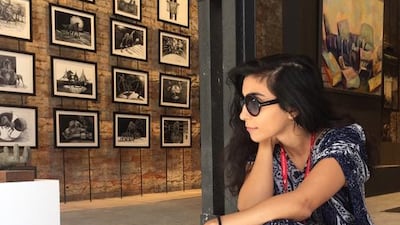Today, after a prolonged summer break, The Art Blog takes up the thread of our popular series in collaboration with the National Pavilion of the UAE at the Venice Biennale. We have tasked the interns, who each spend one month in the Italian city to act as custodians of the UAE’s art pavilion, with bringing us a report from the ground about another national pavilion that particularly moved them.
Here is Sawsan Al Bahar, a Syrian architect and printmaker living in Sharjah, who visited the Turkish Pavilion and discovered an emotional response.
Sawsan writes:
“Visiting the Turkish pavilion has left me in awe. In a world that is becoming increasingly visual and graphic-obsessed, the Turkey Pavilion transcends with its poetry, elegance, simplicity and emptiness. The multimedia installation by Turkish-born Armenian artist Sarkis, consists of two large scale site-specific neon rainbows made from fragile lines of light; a series of 36 illuminated stained glass panes with imagery depicting pain, war, and eros; two large scale-mirrors with fingerprints applied in watercolor by seven children; and sculptures.
It is much more difficult to create drama and command attention from visual emptiness and from that, to design a total sensory experience. Yet this pavilion, curated by Defne Ayas and titled Respiro (Italian for breath) is presented almost as visual emptiness yet is a very powerful sensory experience - for me it was a physical, spatial, sensory, and metaphysical experience.
Sarkis explains: “In Respiro, I will be reaching out beyond the geopolitics to a more expansive context of a million plus years, going back to the creation of the universe and the beginning of time, back to the first-ever rainbow, the very first magical breaking point of light. Instead of binding ourselves to specific instances within the histories of politics, religion, philosophy, and the arts, we will be embracing contemporaneity of both the present and the distant past in our continued attempt to defy stagnation.”
Respiro also features a meditative soundscape - a musical composition by Jacopo Baboni-Schilingi, based on the artist’s rendition of the seven colours of the rainbow as a system of partitions. The soundscape plays all day and all night, rotating around the parameter of the exhibition, breathing along with the lingering translucent drapery, and with the rainbows at either end of the space.
Being an architect, I found the spatial, sensory, and metaphorical experience most fascinating about the installation, and it left me in complete awe. The resonance of the space, the way it is expanded, lengthened, and stretched out beyond the walls of Sale D’Armi building was incredible to me. The poetry and magic was created by the combination of the soundscape that played continuously, with the breathing translucent curtains that almost seemed to be moving in slow motion. The coolness of the space and the beauty of the light quality against the darkness and the neon rainbow lights created an almost contemporary spatial chiaroscuro. The scale of the space becomes comprehensible, material, through the traveling mystifying music with its fortes and crescendos, its diminuendos and brief moments of silence. The mirrors in the centre of the pavilion, on the other hand, render the space elongated and infinite, a paradox that is replicated within the imagery of the stained panes, the rainbows, and the fingerprints as they often overlap to create beautiful visual moments in more than one location around the reflective surfaces within the exhibition.
The Turkish pavilion is truly a full, poetic, and haunting sensory experience, a complete and total universe in itself. Yet it is starkly simple and elegantly effortless.”
* To read more about the pavilion: http://turkiyepavyonu15.iksv.org
* Sawsan Al Bahar describes her work as a bridge between contemporary art production methods and traditional printmaking techniques and often explores themes within Middle Eastern literature, politics, and culture. Keep up with her on Instagram on @veniceinterns as well as on her personal account: @sawsanalbahar and on hashtags #veniceinterns and @uaeinvenice.

